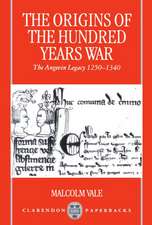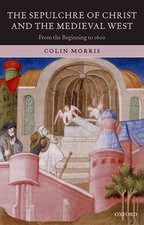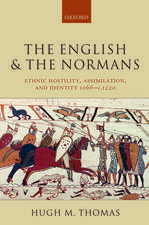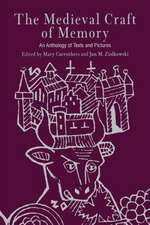Medieval Crossover – Reading the Secular against the Sacred: Conway Lectures in Medieval Studies
Autor Barbara Newmanen Limba Engleză Paperback – 14 mai 2013
Medieval Crossover explores a wealth of case studies in French, English, and Latin texts that concentrate on instances of paradox, collision, and convergence. Newman convincingly and with great clarity demonstrates the widespread applicability of the crossover concept as an analytical tool, examining some very disparate works.These include French and English romances about Lancelot and the Grail; the mystical writing of Marguerite Porete (placed in the context of lay spirituality, lyric traditions, and the Romance of the Rose); multiple examples of parody (sexually obscene, shockingly anti-Semitic, or cleverly litigious); and René of Anjou's two allegorical dream visions. Some of these texts are scarcely known to medievalists; others are rarely studied together. Newman's originality in her choice of these primary works will inspire new questions and set in motion new fields of exploration for medievalists working in a large variety of disciplines, including literature, religious studies, history, and cultural studies.
"As Barbara Newman points out, in the wake of the bruising debates about 'Robertsonianism,' scholars preferred to focus on different kinds of questions, but the work produced during the intervening decades can now fruitfully inform a return, with a somewhat different orientation, to the thorny questions of how the sacred and the secular interact in medieval literary texts, and indeed how and to what extent these categories functioned within medieval cultural imagination. Newman's book tackles these questions head-on in a variety of texts, and is sure to stimulate further research in this area." —Sylvia Huot, University of Cambridge
"In Medieval Crossover, Barbara Newman highlights the ways in which the premodern reader understood 'sacred' and 'secular' not as opposing points on a continuum but as what Newman calls a state of 'double judgment,' where transcendent truths could be understood through paradox or hermeneutic inversion. Exquisitely written, grounded in thoughtful readings of some of the most enigmatic texts of the Middle Ages, Medieval Crossover charts a new course in our understanding of premodern modes of interpretation." —Suzanne Conklin Akbari, University of Toronto
"This outstanding piece of scholarship makes an original contribution to the fields of medieval studies in general as well as more specifically to the study of medieval English and French, or better, francophone literature produced either on the continent or in England. Medievalists working in a large variety of disciplines—historical, sociological, religious, as well as cultural and literary—will find this book of great interest. The general argument for both is completely convincing: specialists as well as general readers of medieval works need to learn about and practice double judgment, and Newman's book gives them wonderful examples of how to do so and what is at stake in the process." —Matilda Tomaryn Bruckner, Boston College
| Toate formatele și edițiile | Preț | Express |
|---|---|---|
| Paperback (1) | 361.36 lei 6-8 săpt. | |
| MR – University of Notre Dame Press – 14 mai 2013 | 361.36 lei 6-8 săpt. | |
| Hardback (1) | 834.30 lei 6-8 săpt. | |
| MR – University of Notre Dame Press – 29 sep 2022 | 834.30 lei 6-8 săpt. |
Preț: 361.36 lei
Nou
Puncte Express: 542
Preț estimativ în valută:
69.16€ • 71.93$ • 57.09£
69.16€ • 71.93$ • 57.09£
Carte tipărită la comandă
Livrare economică 14-28 aprilie
Preluare comenzi: 021 569.72.76
Specificații
ISBN-13: 9780268036119
ISBN-10: 026803611X
Pagini: 416
Ilustrații: 12 halftones
Dimensiuni: 154 x 228 x 27 mm
Greutate: 0.57 kg
Ediția:1st Edition
Editura: MR – University of Notre Dame Press
Seria Conway Lectures in Medieval Studies
ISBN-10: 026803611X
Pagini: 416
Ilustrații: 12 halftones
Dimensiuni: 154 x 228 x 27 mm
Greutate: 0.57 kg
Ediția:1st Edition
Editura: MR – University of Notre Dame Press
Seria Conway Lectures in Medieval Studies
Recenzii
"In Medieval Crossover, Barbara Newman highlights the ways in which the premodern reader understood 'sacred' and 'secular' not as opposing points on a continuum but as what Newman calls a state of 'double judgment,' where transcendent truths could be understood through paradox or hermeneutic inversion. Exquisitely written, grounded in thoughtful readings of some of the most enigmatic texts of the Middle Ages, Medieval Crossover charts a new course in our understanding of premodern modes of interpretation." —Suzanne Conklin Akbari, University of Toronto
"As Barbara Newman points out, in the wake of the bruising debates about 'Robertsonianism,' scholars preferred to focus on different kinds of questions, but the work produced during the intervening decades can now fruitfully inform a return, with a somewhat different orientation, to the thorny questions of how the sacred and the secular interact in medieval literary texts, and indeed how and to what extent these categories functioned within medieval cultural imagination. Newman's book tackles these questions head-on in a variety of texts, and is sure to stimulate further research in this area." —Sylvia Huot, University of Cambridge
"This outstanding piece of scholarship makes an original contribution to the fields of medieval studies in general as well as more specifically to the study of medieval English and French, or better, francophone literature produced either on the continent or in England. Medievalists working in a large variety of disciplines—historical, sociological, religious, as well as cultural and literary—will find this book of great interest. The general argument for both-and is completely convincing: specialists as well as general readers of medieval works need to learn about and practice double judgment, and Newman's book gives them wonderful examples of how to do so and what is at stake in the process." —Matilda Tomaryn Bruckner, Boston College
"Prolific medievalist Newman argues that though the sacred was the default perspective in medieval thinking, the sacred did not exclude the secular: there was ample creative room to blend the two perspectives. . . . A textual study at its best, Newman's work attempts to set the field back on track after years of debate over how to read a medieval text and whether medieval writers used the holy texts literally or could deploy them creatively at times." —Library Journal
"Barbara Newman, in her (as usual) fine study of medieval literature, takes on the debate of the past three decades around 'exegetics' or 'Robertsonianism,' offering a new approach to the sacred and secular in medieval literature. . . . Newman's concise yet readable narrative makes this accessible to non-specialists. Students of medieval literature, literary criticism, and hermeneutics will appreciate Newman's keen insights." —Magistra
“A fascinating work that offers a novel approach to medieval literature. . . . The depth of Newman’s scholarship and her engaging style strongly support her powerful, invigorating claims about medieval literature.” —Choice
“This important book should be read by anyone with a serious interest in medieval English and French literature, the Bible and literature, the history of medieval theology (Latin and vernacular), and the vital and complex manifestations of sacred and secular motifs in Western thought.” —Renaissance Quarterly
“The strengths of Medieval Crossover are manifold. . . . This is essential reading for students of history, religion, literature, and cultural studies, with sensitive English translations catering to readers who lack proficiency in Latin or Medieval French. Like those medieval texts that open themselves up to ‘double judgment,’ Medieval Crossover is guaranteed to provoke further debate and delight.” —French Studies
“Although Newman acknowledges her debt to other critics who have drawn attention to the use of paradox—the both/and—in the Middle Ages, her work itself is a strong contribution to this field of study. Instead of examining only the presence of sacred and secular, her work illustrates the different ways that the sacred and secular are integrated and does so in a text that is easily accessible to the reader.” —Sixteenth Century Journal
“The undeclared subject of this book is nothing less amazing or mysterious than the procreation of life through art. From the altitude of a medium-earth-orbit satellite, Newman’s ‘meandering path’ and its side-tracks describe an intricate pattern, crisscrossing and double-crossing, as elaborate as the swiveling of Love. . . . Thanks to Newman’s game-changing encore to the Donaldson/Robertson debate, we now can see a way to speak of crossovers between secular and sacred as tools of indigenation, and of indigenation as a protean driver in the evolution of social values.” —The Medieval Review
“The strengths of Medieval Crossover are manifold. . . . This is essential reading for students of history, religion, literature, and cultural studies, with sensitive English translations catering to readers who lack proficiency in Latin or Medieval French. Like those medieval texts that open themselves up to ‘double judgment,’ Medieval Crossover is guaranteed to provoke further debate and delight.” —French Studies
“Although Newman acknowledges her debt to other critics who have drawn attention to the use of paradox—the both/and—in the Middle Ages, her work itself is a strong contribution to this field of study. Instead of examining only the presence of sacred and secular, her work illustrates the different ways that the sacred and secular are integrated and does so in a text that is easily accessible to the reader.” —Sixteenth Century Journal
“The undeclared subject of this book is nothing less amazing or mysterious than the procreation of life through art. From the altitude of a medium-earth-orbit satellite, Newman’s ‘meandering path’ and its side-tracks describe an intricate pattern, crisscrossing and double-crossing, as elaborate as the swiveling of Love. . . . Thanks to Newman’s game-changing encore to the Donaldson/Robertson debate, we now can see a way to speak of crossovers between secular and sacred as tools of indigenation, and of indigenation as a protean driver in the evolution of social values.” —The Medieval Review
“Understanding these texts in conversation as crossover works, as Newman does, enriches and complicates our reading of each. . . . This book will be essential reading for any student of religion, history, or literary studies and will doubtless inspire much scholarship to come.” —Comitatus: A Journal of Medieval and Renaissance Studies
“In the conclusion, Newman generously identifies her work as laying a path to be pursued by others. In addition to the method it outlines, Medieval Crossover provides the ground for exploring why so many medieval texts and genres—in serious and playful registers—construct an inextricable relationship between the secular and the sacred, even when they seem most antithetical to one another.”—Studies in the Age of Chaucer
“Beyond the field of late medieval literary studies, Medieval Crossover is a must-read for scholars in any discipline concerned with secularization and passage to modernity. Medieval Crossover is the most powerful book about the interaction of pre-modern sacred and secular literary cultures since D.W. Robertson’s A Preface to Chaucer.” —Modern Philology
“Newman’s book works against the effects of Robertson’s totalizing program, and on that score alone its contribution is considerable. . . Newman thus reveals a strain in medieval literary history with long antecedents and wide application. It would seem to have been waiting a long time to be revealed. On this view, then, Newman’s book is revelatory.” — Comparative Literature Studies
“[Newman] aptly reminds us of the distance between the modern and the medieval, noting how sometime between 1600 and 1900 the secular rather than the sacred becomes the default category of Western culture. . . . Having herself ‘crossed over’ from English literature to French, and from religious texts to secular romance, Newman’s enthusiasm for this ‘crossover’ will fruitfully enrich the contacts between these academic fields.” —Speculum
“In the conclusion, Newman generously identifies her work as laying a path to be pursued by others. In addition to the method it outlines, Medieval Crossover provides the ground for exploring why so many medieval texts and genres—in serious and playful registers—construct an inextricable relationship between the secular and the sacred, even when they seem most antithetical to one another.”—Studies in the Age of Chaucer
“Beyond the field of late medieval literary studies, Medieval Crossover is a must-read for scholars in any discipline concerned with secularization and passage to modernity. Medieval Crossover is the most powerful book about the interaction of pre-modern sacred and secular literary cultures since D.W. Robertson’s A Preface to Chaucer.” —Modern Philology
“Newman’s book works against the effects of Robertson’s totalizing program, and on that score alone its contribution is considerable. . . Newman thus reveals a strain in medieval literary history with long antecedents and wide application. It would seem to have been waiting a long time to be revealed. On this view, then, Newman’s book is revelatory.” — Comparative Literature Studies
“[Newman] aptly reminds us of the distance between the modern and the medieval, noting how sometime between 1600 and 1900 the secular rather than the sacred becomes the default category of Western culture. . . . Having herself ‘crossed over’ from English literature to French, and from religious texts to secular romance, Newman’s enthusiasm for this ‘crossover’ will fruitfully enrich the contacts between these academic fields.” —Speculum
Notă biografică
Barbara Newman is professor of English, religious studies, and classics at Northwestern University. She is the author of a number of books, including God and the Goddesses: Vision, Poetry, and Belief in the Middle Ages and Frauenlob’s Song of Songs: A Medieval German Poet and His Masterpiece.


























